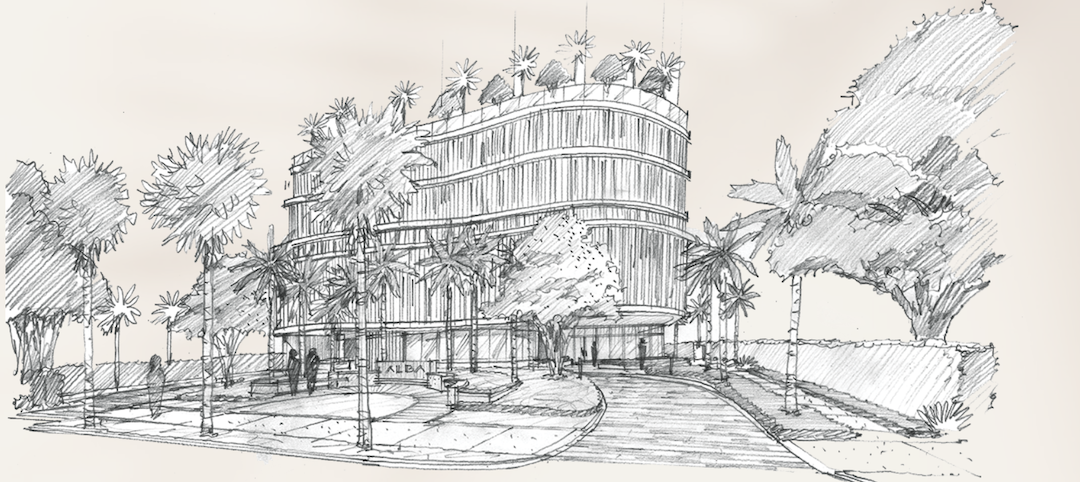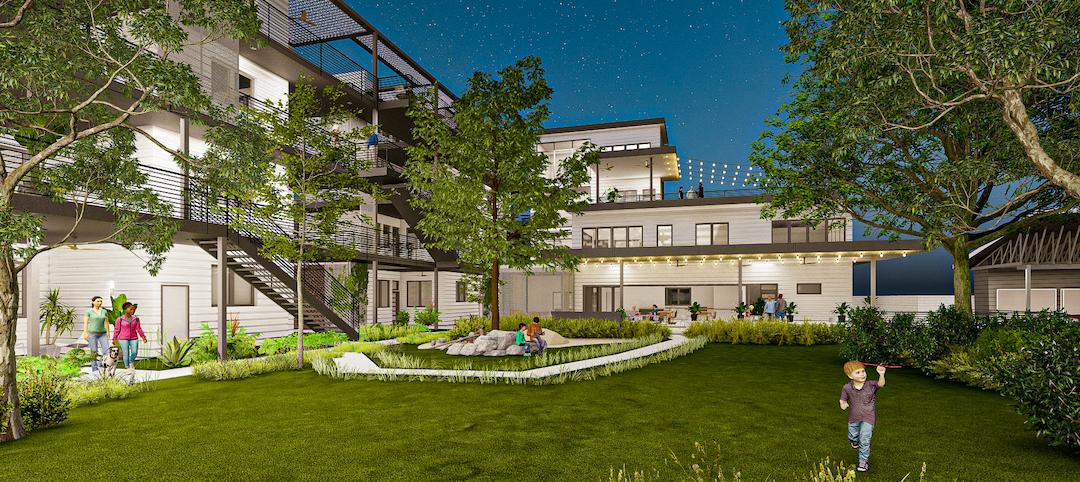A growing appetite for outdoor living spaces is fueling an expansion of outdoor kitchens on roof decks, terraces, and courtyards.
“In the last few years, we’ve seen an enormous increase in demand as high-end rental properties, condos, and townhomes take advantage of the indoor-outdoor living phenomenon,” said Mitch Slater, Founder/President, Danver Stainless Outdoor Kitchens (danver.com).
The design of these open-air amenity spaces has evolved from standalone grill stations to sophisticated meal preparation and dining environments that emphasize convenience and community. “These days, the goal is to get people to stay outside longer and have a great experience,” said Kristen Larkin, ASID, Associate Principal, FitzGerald Associates Architects, Chicago.
Although there’s no standard template for outdoor kitchens, designers and manufacturers we spoke with shared practical advice for ensuring these amenity spaces deliver safe, memorable experiences for residents and guests.
1. Design a simple, logical layout. L-shape, U-shape, and island layouts are common configurations for outdoor kitchens. Marieke Lacasse, ASLA, LEED AP BD+C, Principal at Seattle-based design firm GGLO, recommends locating them close to the pool area or party room to create a social hub and event space. “Outdoor kitchens are places to congregate around food, so it’s important to provide adequate food prep areas, sink space, and support surfaces,” she said.
‘Outdoor living is here to stay, so not having an outdoor kitchen really devalues your asset.’
—Marieke Lacasse, GGLO
Larkin likes to engage the management company that will maintain the space early in the design process, to ensure everyone’s goals are aligned. “I want to make sure any decisions I make on their behalf are in the long-term interests of the building owner,” she said.
2. Provide indoor-outdoor continuity. The growing popularity of sliding glass walls opens the door for outdoor kitchens to function as extensions of the interior environment. “Interior designers need to work closely with landscape architects to achieve design continuity between these areas,” said Jason Valentin, Associate IIDA, Interior Design Coordinator at Stantec.
Team collaboration extends to design details. “Don’t just think programmatically about how the spaces work together, but think also about the overall language of materiality such as patterns, colors, and metals,” said Lacasse. “Every little detail needs to be thought through to create a cohesive indoor-outdoor connection.”

Toni Wendel, Owner of Olde World Builders and Remodelers, chose Danver Stainless Outdoor Kitchens cabinetry with green powder-coat finish for this condo building in New Orleans’s historic Warehouse District. Photo: Chad Chenier Photography
3. Select durable, easy-to-maintain materials. “We push for sturdy, stable baseline construction materials,” said Larkin, who favors steel trellises over all-wood structures. She recommends easy-to-maintain surfaces such as stainless steel cabinetry and granite countertops. Powder-coated stainless steel cabinetry offers added protection against moisture damage. Powder coatings can also be colored, opening up design possibilities.
The inevitable spills and splatters from shared grills should be considered when selecting flooring materials. “We’ve learned to use darker pavers in front of barbecue spaces, because grease is more visible on lighter-colored pavers and they stain easily,” said GGLO’s Lacasse.
4. Emphasize safety and accessibility. To protect residents and guests from the potential hazards of open flames and hot surfaces, locate grills, ovens, and fire pit tables in sheltered environments away from high-wind areas—or use a flameless electric grill. All adjacent structures should use fire-resistant building materials, such as fire-treated wood or light-gauge aluminum frame.
Designers also must follow ADA accessibility requirements for kitchens: providing adequate clearance areas and adhering to surface height requirements for sinks, appliances, cabinets, countertops, and food prep areas.
5. Take local climate into consideration. In colder climates sinks, icemakers, and refrigerators that have outdoor plumbing need to be winterized. “If an outdoor sink isn’t feasible, it’s important to consider adjacencies—how far will a resident have to carry a dirty spatula from the grill to an indoor sink to clean it?” said Larkin.
Humid environments and extreme weather events pose their own problems. “In Miami, we need to specify marine-grade materials such as plywood and cement board as a substrate for the millwork and cabinetry,” said Stantec’s Valentin. “We wouldn’t specify a typical laminate that we might use in an interior space.”

Pappageorge Haymes Partners installed this rooftop outdoor kitchen suite at LUXE on Madison (P II), a four-story, 44-unit apartment community in Chicago’s West Loop. Fifield Development is the developer. Photo courtesy Pappageorge Haymes Partners
6. Use lighting to enhance the ambience. Because nighttime is prime time for grilling, effective lighting is essential for maximizing safety and functionality. Our experts recommend using subtle, indirect lighting strategies that meet local outdoor lighting code requirements while maintaining an ambience conducive to a relaxing night under the stars.
Wind can play havoc with decorative lighting fixtures. FitzGerald’s Larkin suggests using softer bounce lights and integrating the lighting into a trellis or overhead structure to make the space feel more intimate.
7. Offer cooking options. Multifamily developers are expanding their cooking repertoire to include electric cooktops, smokers, and pizza ovens. Manufacturers like Danver offer commercial-grade bartending stations and mobile F&B service carts.
Properties with space or budget constraints can still raise their game. Thor Kitchen (thorkitchen.com) offers a compact modular outdoor kitchen suite that has a gas grill, side burner, wood-burning pizza oven, refrigerator drawers, grill cabinet, sink cabinet, corner cabinet, and appliance cabinet. Danver’s Post and Panel System employs powder-coated stainless steel panels that ship flat and can be installed in the cabinetry even with the countertop in place.
Do outdoor kitchens enhance a property’s marketability? Yes, said GGLO’s Lacasse. “All the best properties have them,” she noted. “The outdoor living trend is definitely here to stay, so not having an outdoor kitchen really devalues your asset.”
Related Stories
Multifamily Housing | Feb 24, 2022
First new, mixed-use high-rise in Detroit’s central business district in nearly 30 years opens
City Club Apartments completed two multifamily projects in 2021 in downtown Detroit including the first new, mixed-use high-rise in Detroit’s central business district in nearly 30 years.
Codes and Standards | Feb 21, 2022
More bad news on sea level rise for U.S. coastal areas
A new government report predicts sea levels in the U.S. of 10 to 12 inches higher by 2050, with some major cities on the East and Gulf coasts experiencing damaging floods even on sunny days.
Urban Planning | Feb 14, 2022
5 steps to remake suburbs into green communities where people want to live, work, and play
Stantec's John Bachmann offers proven tactic for retrofitting communities for success in the post-COVID era.
Senior Living Design | Feb 11, 2022
Design for senior living: A chat with Rocky Berg, AIA
Rob Cassidy, Editor of MULTIFAMILY Design + Construction, chats with Rocky Berg, AIA, Principal with Dallas architecture firm three, about how to design senior living communities to meet the needs of the owner, seniors, their families, and staff.
Multifamily Housing | Feb 8, 2022
Suffolk to build Alba Palm Beach
The project will feature 55 residences.
| Feb 4, 2022
New apartment complex Dixon Place honors the history of Salt Lake City
Salt Lake City’s Sugar House neighborhood has been experiencing somewhat of a renaissance as of late, and the opening of new apartment community Dixon Place continues that trend. MVE + Partners took leadership in the design of the 59-unit, Class A development.
Sponsored | Steel Buildings | Jan 25, 2022
Multifamily + Hospitality: Benefits of building in long-span composite floor systems
Long-span composite floor systems provide unique advantages in the construction of multi-family and hospitality facilities. This introductory course explains what composite deck is, how it works, what typical composite deck profiles look like and provides guidelines for using composite floor systems. This is a nano unit course.
Multifamily Housing | Jan 20, 2022
Texas’ first cohousing residential community breaks ground in East End Houston
The design will include sustainability elements.
Coronavirus | Jan 20, 2022
Advances and challenges in improving indoor air quality in commercial buildings
Michael Dreidger, CEO of IAQ tech startup Airsset speaks with BD+C's John Caulfield about how building owners and property managers can improve their buildings' air quality.
Multifamily Housing | Jan 13, 2022
Astra Tower will be Salt Lake City’s tallest high-rise
HKS designed the project.

















